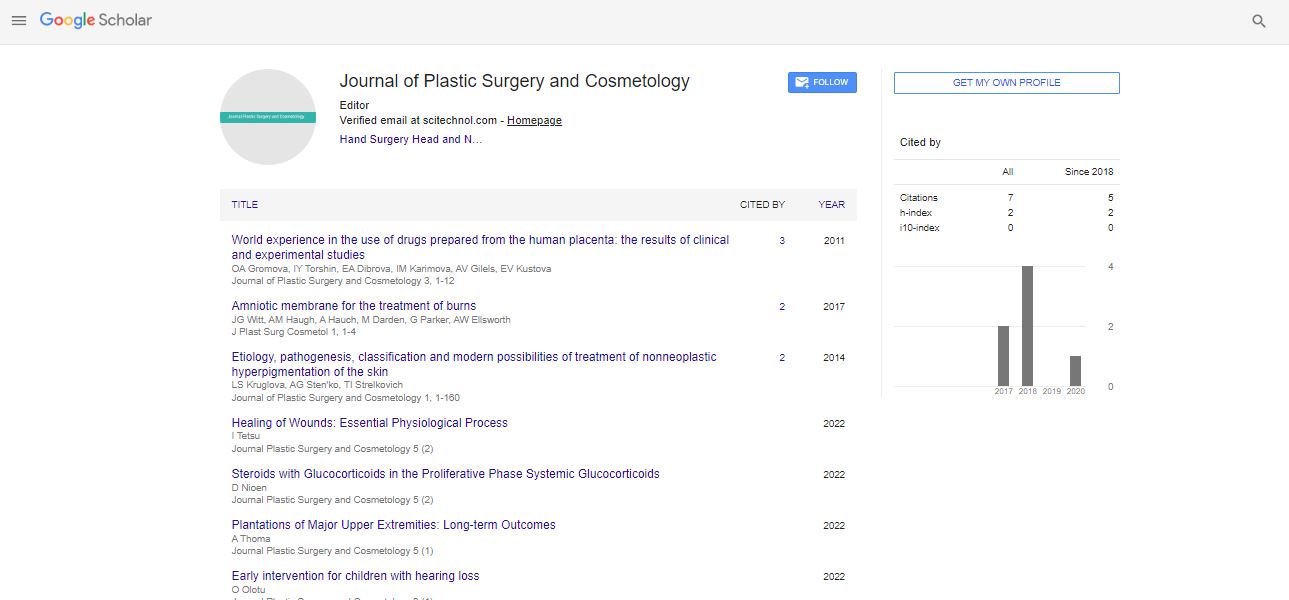Perspective, J Pls Sur Cos Vol: 12 Issue: 2
Reconstructing Faces: Exploring the Latest Techniques and Clinical Applications of Maxillofacial Surgery
Cheng Saman*
Department of General Surgery, Mackay Memorial Hospital, Taipei, Taiwan
*Corresponding Author: Cheng Saman,
Department of General Surgery, Mackay Memorial Hospital, Taipei, Taiwan;
E-mail: Samancheng700@hotmail.com
Received date: 29 May, 2023, Manuscript No. JPSC-23-107417;
Editor assigned date: 31 May, 2023, PreQC No. JPSC-23-107417(PQ);
Reviewed date: 14 June, 2023, QCNo JPSC-23-107417;
Revised date: 21 June, 2023, Manuscript No. JPSC-23-107417(R);
Published date: 30 June, 2023, DOI: DOI: 10.4172/JPSC.100055
Citation: Saman C (2023) Reconstructing Faces: Exploring the Latest Techniques and Clinical Applications of Maxillofacial Surgery. J Pls Sur Cos 2023, 12:1.
Description
Maxillofacial surgery encompasses a wide range of surgical procedures involving the facial skeleton, jaws, and related structures. This study provides an overview of the current approaches and clinical applications of maxillofacial surgery. It discusses the management of facial trauma, orthognathic surgery for corrective jaw procedures, and surgical interventions for craniofacial anomalies, such as cleft lip and palate. Additionally, explore the emerging trends in maxillofacial surgery, including the use of virtual surgical planning, computerassisted surgery, and the integration of regenerative medicine. The manuscript concludes with a discussion on the multidisciplinary nature of maxillofacial surgery and the importance of collaboration among various specialties.
Maxillofacial surgery is a specialized field that involves the diagnosis, treatment, and management of conditions affecting the facial skeleton, jaws, and related structures. This manuscript aims to provide an overview of the current approaches and clinical applications of maxillofacial surgery, focusing on facial trauma, corrective jaw procedures, and craniofacial anomalies. Additionally, explore the emerging trends and technologies that are shaping the future of this field.
Advancements in imaging technology, such as Cone-Beam Computed Tomography (CBCT) and virtual surgical planning, have revolutionized maxillofacial surgery. These tools allow for detailed three-dimensional evaluation of facial structures and aid in precise surgical planning, resulting in improved surgical outcomes and reduced complications.
Moreover, ongoing advancements in tissue engineering and regenerative medicine hold hope for the reconstruction of craniofacial defects. Researchers are exploring novel approaches using biomaterials, stem cells, and bioengineered scaffolds to enhance bone healing and soft tissue regeneration in maxillofacial surgery. Orthognathic surgery, another important aspect of maxillofacial surgery, focuses on correcting skeletal discrepancies of the jaws. This procedure involves repositioning the maxilla (upper jaw) and mandible (lower jaw) to improve bite alignment, facial aesthetics, and airway function. Orthognathic surgery can effectively address issues such as malocclusion, facial asymmetry, and obstructive sleep apnea.
Maxillofacial surgery plays an important role in the management of facial trauma, ranging from simple fractures to complex injuries involving multiple facial bones. The goals of treatment include restoration of facial aesthetics, function, and occlusion. Orthognathic surgery addresses skeletal discrepancies of the jaws, such as malocclusion, by repositioning the maxilla and mandible. This procedure not only improves bite alignment but also enhances facial aesthetics and airway patency. Surgical interventions for craniofacial anomalies, such as cleft lip and palate, involve a multidisciplinary approach, including maxillofacial surgeons, plastic surgeons, orthodontists, and speech therapists. These surgeries aim to restore normal form and function while optimizing speech and facial aesthetics.
Advancements in imaging technologies, such as cone-beam computed tomography and virtual surgical planning have revolutionized maxillofacial surgery by facilitating accurate preoperative assessment and surgical simulation. Computer-assisted surgery enables precise execution of surgical plans, improving surgical outcomes and reducing morbidity. Additionally, regenerative medicine approaches, including bone grafting and tissue engineering, hold hope for enhancing bone healing and reconstruction in maxillofacial defects. The multidisciplinary nature of maxillofacial surgery necessitates collaboration among various specialties, emphasizing the importance of a comprehensive team approach.
Conclusion
Maxillofacial surgery encompasses a diverse range of procedures, including the management of facial trauma, corrective jaw surgery, and craniofacial anomalies. Advances in imaging technology, computerassisted surgery, and regenerative medicine have enhanced surgical precision and outcomes. The multidisciplinary nature of maxillofacial surgery highlights the significance of collaborative care to ensure optimal results for patients. Continued research and innovation in this field will further improve patient outcomes and contribute to the advancement of maxillofacial surgery.
 Spanish
Spanish  Chinese
Chinese  Russian
Russian  German
German  French
French  Japanese
Japanese  Portuguese
Portuguese  Hindi
Hindi 